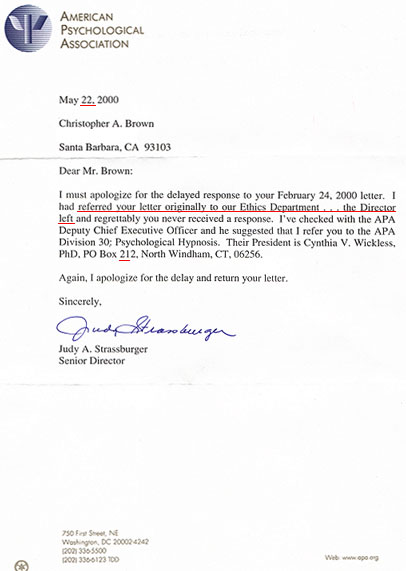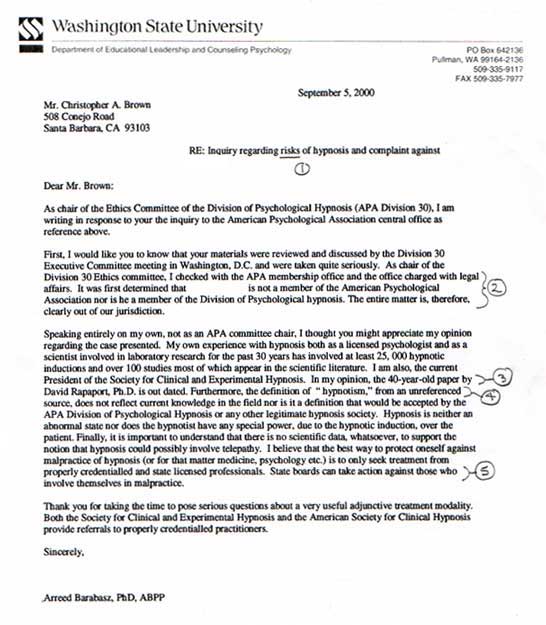
AMERICAN PSYCHOLOGICAL ASSOCIATION

I can only assume that the director is doing everything she can within her programming, to affirm my questions of the letter to the A.P.A.
SECOND LETTER TO THE A.P.A. AS REFERRED

ATTN; President, Cynthia V. Wickless PhD.
A.P.A. Division 30, Psychological Hypnosis
PO Box 212, North Windham, CT, 06256
5/29/00
RE; Letter to A.PA. of 2/24/00, response from Judy A. Strassburger, Senior Director and reference to Division 30.
Dear Cynthia V. Wickless PhD.,
Included with this letter are my original letter to the A. P.A. received 2/24/00 as well as the copied texts accompanying the letter. Also, attached to this letter, is the response letter from Senior Director Judy A. Strassburger. The second sentence of that letter is quite disturbing and implies that my original letter, referred to the Ethics Department, was recognized there as defining a MAJOR breach of ethics. The implication is derived from the information that the Director of the Department left. Based on that implication I convey to you that what is happening is not about blame, it is about understanding, protecting and healing lives.
Protecting lives at this point can be best achieved with a condition perceived by the public. That condition is a media distributed, clinical, affirmative recognition of the potentials of questions; A., B., C., and D., of my original letter to the A.P.A. by the A.P.A.. Medically, the recommendations to the California State Department of Mental Health requested in the February letter will serve best to accommodate effective treatments and actual healing, further protecting human life.
With regard to the import of the last sentence and the delay of response to the February letter to the A.P.A., I include a self addressed and stamped envelope to facilitate immediate confirmation of action or response to this letter, or by reference, the requests of the first letter. Please advise soon.
Thank you sincerely,
Christopher A. Brown
EVENTUAL RESPONSE?
Here is the response. Notice it does not come from the A.P.A. The A.P.A. unconsciously knows that the potential abuses of hypnosis, particularly somnambulism, include the behaviors that are epidemic in our society today. Instead of responding, the A.P.A. refers the matter to someone who is capable of passionate, irrational dissociation, in the hope I will be satisfied. My reactions to this letter details the noted, bracketed areas of the communication from Washington State University.

1. I had referred to "ABUSES" Barabasz distorts "minimizing" the issue. A cognitive distortion.
2. Ihad not asked if the person mentioned was a member of the A.P.A. I know they are not.
3. If the 30 year old paper is "out dated" what is the new reference comprehensive to my issues? Without that information this is a another cognitive distortion of "minimumization"
4. The source is Black Law Distionary, named and attached, is linked in my letter below.
5. Barabasz does not know that it is absolutely legal to hypnotise a person wthout their awareness in California so licensure is not competent if it does not include investigation of abuses.
ORIGINAL LETTER TO THE A.P.A.
If Mr. Barabasz were fully rational the letter above would have actually responded to the issues and inquiry set forth in this letter. It does not even try. In fact the first thing it does is a "repressional" or dissociative reaction by diminishing the seriousness of what I present with the term "risk" in RE; instead of "abuses". The text included with the letter is linked to this version.
ATTN; Chairman of the Board of Directors
American Psychological Association
750 First Street, NE
Washington, DC 20002
2/15/00
RE; Cover letter and request for review of recommendations to C.S.M.H.
Dear Institute executives,
The included copy of EMOTIONS and MEMORY by David Rapaport, Ph.D.,1961, contains information vital to the safety and well being of Americans. The information indicates possible parameters for severe abuses of the knowledge of hypnosis beyond what has been accepted. As can be seen in the included opening statement by the attorney of the defendant in a civil action where I was the plaintiff, there is a statement that the plaintiff claims to have been "inflicted" with "harmful hypnotic telepathy". As the plaintiff I have never used the word telepathy. Consider that the defendant intends to introduce the language into legal proceedings as information for the use in the practice of psychology.
However psychologists are unwilling to comment on the material, obviously fearful of making legal precedent. This not a competent reaction and offensive in light of available information.
It is reasonable for me to state that the understandings by psychology of the extreme potentials of hypnotic abuses, for the sake of public safety, are necessary with or without legal consideration. The highlighted areas from page 172 to 182 of EMOTIONS and MEMORY as well as the two pages of opening statement and page 911 of Blacks Law, 1933 defining hypnotism, require integration with inference to answer these questions and thereby relieve, or make competent, practitioners in the field of psychology.
A. Can a person be hypnotized without their awareness?
B. Can barriers preventing memories be built with hypnosis?
C. Is memory dependent on meaning or emotion with hypnosis?
D. Could "transference" during hypnosis be an impression of telepathy?
If these questions can approximately answered by the appropriate specialists, with an affirmative, recommendations of the American Psychological Association, to psychologists, serving generally public safety, health and welfare, by establishing a need for appropriate information to the public concerning the possibilities of abuses and the effective treatments, should be made. Please advise me of your actions in this matter.
Thank you sincerely,
Christopher A. Brown